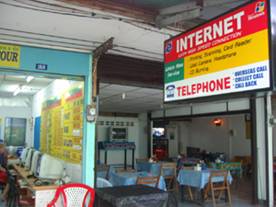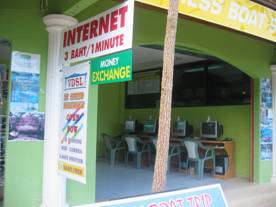Announcements |
|
 New Book: ARNIC co-founder Jonathan Aronson's new book (with Peter Cowhey of UCSD and now the Senior Counselor at USTR and a contribution by former official Don Abelson) has been published by MIT Press. The book, Transforming Global Information and Communication Markets: The Political Economy of Innovation is available for free download under a Creative Commons license at : http://www.globalinfoandtelecom.org. The authors would welcome your comments, criticisms, and corrections. New Book: ARNIC co-founder Jonathan Aronson's new book (with Peter Cowhey of UCSD and now the Senior Counselor at USTR and a contribution by former official Don Abelson) has been published by MIT Press. The book, Transforming Global Information and Communication Markets: The Political Economy of Innovation is available for free download under a Creative Commons license at : http://www.globalinfoandtelecom.org. The authors would welcome your comments, criticisms, and corrections.
 Recent Book, Edited by Hernan Galperin and Judith Mariscal,Digital Poverty:
Latin American and Caribbean Perspectives,
Practical Action Publishing/IDRC 2007 Recent Book, Edited by Hernan Galperin and Judith Mariscal,Digital Poverty:
Latin American and Caribbean Perspectives,
Practical Action Publishing/IDRC 2007
 Recent Book, by Manuel Castells, Mireia Fernandez - Ardevol, Jack Linchuan Qiu and Araba Sey: Mobile Communication and Society: A Global Perspertive, (MIT Press, 2006) [more info from MIT Press] Now available in Spanish Recent Book, by Manuel Castells, Mireia Fernandez - Ardevol, Jack Linchuan Qiu and Araba Sey: Mobile Communication and Society: A Global Perspertive, (MIT Press, 2006) [more info from MIT Press] Now available in Spanish
 Recent Book, edited by Manuel Castells and Gustavo Cardoso: The Network Society: From Knowledge to Policy (Washington DC: Johns Hopkins Center for Transatlantic Relations, 2006); also available in Portuguese as A sociedade em Rede: Do Conhecimento à Acção Política, Imprensa Nacional, Casa da Moeda, Lisboa , 2006. Includes chapters by Jonathan Taplin, Jeffrey Cole, Hernán Galperin and François Bar. (free download in both languages) Recent Book, edited by Manuel Castells and Gustavo Cardoso: The Network Society: From Knowledge to Policy (Washington DC: Johns Hopkins Center for Transatlantic Relations, 2006); also available in Portuguese as A sociedade em Rede: Do Conhecimento à Acção Política, Imprensa Nacional, Casa da Moeda, Lisboa , 2006. Includes chapters by Jonathan Taplin, Jeffrey Cole, Hernán Galperin and François Bar. (free download in both languages)
Recent Book, edited by Hernán Galperin and Judith Mariscal: Digital Poverty: Latin American and Caribbean Perspectives
[download PDF]
Research Notes:
Tsunami Field Notes – Phi Phi Island, Thailand
Seungyoon Lee, 23rd July – 28th July, 2005
Mobile Phones for Disaster Preparedness
Arul Chib & Seungyoon Lee, September 2005
Reviews
William Davies, of the Institute for Policy Research, reviews Hernán Galperin's New Television, Old Politics in New Media & Society 7(2) |
|
|
Research Note
(part of our project on mobile phones and tsunami preparedness)
Mobile Phones for Disaster Preparedness
Tsunami Field Notes – Phi Phi Island, Thailand
Seungyoon Lee, 23rd July – 28th July, 2005 |
|
i. Infrastructure availability post-tsunami
- When Phi Phi Island was severely struck by two huge Tsunami waves, most of the communication infrastructure, electricity, water facilities broke down - Internet shops along the bay and in the villages behind were disappeared or damaged.
- Lack of infrastructure makes recovery a slow process: The scarcity of electricity is a big barrier. Among three electricity generators that were in operation before Tsunami, only one is restored after the Tsunami. Recovery of water purification system and water reservoir is in process.
- There is no telephone cable between Phi Phi and the mainland. Connection is by satellite and wireless networks were deployed in the island prior to Tsunami. Landline telephone services became unavailable in hotels and residential areas after Tsunami.
- Local residents involved in tourism industry and recreational sports are experimenting with shared Wi-Fi signal by setting up wireless routers. Mobile phone is the main communication tool for relief workers, residents, and tourists.
iI. Technological Development and Tsunami alert system (adapting ICTs for rural users)
- Mobile phone is being incorporated into the last-mile solutions for emergency communications. In Sumatra earthquake and Tsunami alert in July 2005, mobile phone and text messaging (SMS), combined with word-of-mouth, played a crucial role in relaying the Tsunami alert that was broadcasted from the traditional media such as TV and local radio. Residents and tourists evacuated to higher locations and the whole process was quick and smooth. Since the December 26, 2004 Tsunami, alarm networks have been somewhat over-reactive and issued three more alerts, resulting in the issue of “the reliability of information” to be questioned by local inhabitants. Overload of phone network in emergency situation is another issue to be dealt with.
- Tsunami Alert System (TAS) has been installed since February, 2005. SMS alert messages have been sent through mobile phones to members of the network who are the government officers in Thailand so far (http://www.wap.ait.ac.th/tsunami.html) There are several other initiatives, for example Alert Retrieval Cache (ARC), to use text messages for instantaneous mass alert for Tsunami warning. (http://www.knowprose.com/ARC)
III. Current relief efforts and Community Involvement (role of ICTs in assisting disaster relief/coordination)
- There are much immediate restoration work still to be done including waste disposal, housing, electricity recovery, water service and coral clean-up. Local residents think that both human and material aids and donation have not been sufficient and Tsunami relief funds both from government and private sectors have not been delivered in a transparent way.
- Relief works: Hi Phi Phi International (hiphiphi.com, hiphiphi.org), the community-based initiative of local residents and international volunteers, coordinates most of the relief work and volunteer activities in the island. Works involve street and underwater coral cleanup, rebuilding of shelters and local shops, and environmental activities such as recycling for the restoration of the island. The organization works as a hub for coordinating tourists and volunteers by setting up a volunteer registration center, by gathering and disseminating information of ongoing relief activities, and offering guided tour of the island. An environmental project Phi Phi Releve Toi (phiphi-releve-toi.com) under the name of Phi Phi Tsunami Relief Fund is a locally run program to finance and repair the long tail boat of local fishermen in Phi Phi. En cooperation. Local dive centers (The Adventure Club, Hippo Divers, etc.) are leading a large part of the relief work such as coral clean-up, street clean-up, and coordination of activities such as Tsunami dive camp for the recovery of undersea environment.
- Major rehabilitation work involves the reconstruction of shelters. It is expected that rebuilding on the island will take some time due to the conflict between local inhabitants and the Thailand government. While the government is trying to use the opportunity to rebuild a cleaner, neater beachfront and tourist infrastructure, the local inhabitants are insisting their way of life before Tsunami.
 Community-based relief organizations (hiphiphi.com) Community-based relief organizations (hiphiphi.com) |
 Community-based relief organizations (phiphi-releve-toi.com) Community-based relief organizations (phiphi-releve-toi.com) |
IV. Effectiveness of current communication infrastructure in terms of their ability to help in building the economy, job-generation, news gathering, etc
- At the initial stage of Tsunami relief, Internet websites and blogs were used to set up a database that collects information on missing persons and identify victims in collaboration with embassies, Thailand CSI, and Thailand CIFS (Central Institute of Forensic Science) (www.internetaid.org, www.missingpersons.or.th, www.thailandtsunami.com, tsunamimissing.blogspot.com)
- The Internet shops are the main resource of telecommunications services to the visitors. As most of the tourists on the island rely on the Internet shops to check mail and surf the web, some high speed Internet cafes are back in business with gradual rebuilding efforts and the return of tourists. Internet browsing costs approximately 3 Baht per minute, which is more expensive than the Internet shops in mainland (mostly 1-2 Baht per minute in Phuket and Bangkok). The cafes offer overseas call, collect call, and call back services, printing, web camera services. Most of the cafes have 5-10 desktop workstations with web cameras installed. The cafes target travelers as main customers, while local Thai inhabitants rarely access to the Internet. None of the local activities in economic, educational, or political sector is linked to the information or applications on the Internet.
- Relief works are coordinated through the Internet. Organizational websites offer information on relief processes and coordinate international participation for volunteering and donations.

|
 |
| Internet shops back in business |
v. Government/NGOs in relief work
- A small amount of relief fund given to local businesses by government was used at the very initial stage of Tsunami recovery for retrieving corpse and building coffins. No subsequent funds were provided to the local businesses.
- Some the barriers in the relief and rehabilitation phase are:
- The inefficient allocation of Tsunami relief resources and donations. Local relief workers were not satisfied with the allocation of funds and were pointing out political corruptions in the process
- Political and cultural conflict between local residents (mostly Muslim) and the government
- Most of the immediate relief workers and NGOs that were involved in the initial rehabilitation have left.
- Lack of basic infrastructure is causing the delay of advanced relief works and rehabilitation.
Note: Telecommunications infrastructure before Tsunami: Until 1994 there were only 12 phones with 075 (Krabi Province prefix) relayed to the only antenna at the Phi Phi Cabana Hotel. This meant that all other businesses used old fashioned radio phones that connected to Krabi and the rest of Thailand. In 1999 UBC satellite television arrived and suddenly exposed the island to CNN, BBC but most importantly, Premier League football from England. In the same 6 months Internet arrived and then finally another mast was erected to connect mobile phones. From 1998-2000 the island was taken by storm by a telecommunications and information technology revolution. Cable TV arrived and in October 1999. The first server brought internet connections. Finally, at about the same time of the arrival of Leonardo Di Caprio a GSM transmitter was connected on the island. Resorts are connected with 802.11b +802.11g, 55Mbps Wi-Fi through Thai-Fi (Partner: Hitel, Exers)
(http://www.phi-phi.com/articles-phi-phi-info/)
|
|